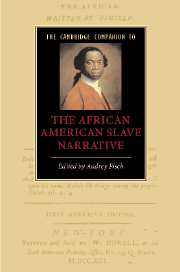Book contents
- Frontmatter
- Introduction
- Part I: The Slave Narrative and Transnational Abolitionism
- Part II: The Slave Narrative and Anglo-American Literary Traditions
- 5 Redeeming bondage: the captivity narrative and the spiritual autobiography in the African American slave narrative tradition
- 6 The slave narrative and the revolutionary tradition of American autobiography
- 7 The slave narrative and sentimental literature
- Part III: The Slave Narrative and the African American Literary Tradition
- Part IV: The Slave Narrative and the Politics of Knowledge
- Further Reading
- Index
7 - The slave narrative and sentimental literature
from Part II: - The Slave Narrative and Anglo-American Literary Traditions
Published online by Cambridge University Press: 28 July 2007
- Frontmatter
- Introduction
- Part I: The Slave Narrative and Transnational Abolitionism
- Part II: The Slave Narrative and Anglo-American Literary Traditions
- 5 Redeeming bondage: the captivity narrative and the spiritual autobiography in the African American slave narrative tradition
- 6 The slave narrative and the revolutionary tradition of American autobiography
- 7 The slave narrative and sentimental literature
- Part III: The Slave Narrative and the African American Literary Tradition
- Part IV: The Slave Narrative and the Politics of Knowledge
- Further Reading
- Index
Summary
Always it gave me a pain that my children had no lawful claim to a name.
(Incidents in the Life of a Slave Girl)“Monsieur, je m'appelle Ellen M...”
She stopped short, in utter and blank uncertainty what to call herself;
Montgomery she dared not; Lindsay stuck in her throat.
(The Wide, Wide World)Slave narratives are famously or, more precisely, infamously surrounded by the voices of white men and women. Their function is to vouch for the integrity of the narrator and to authenticate the facts of her narrative lest a suspicious reader think that a slave remembers too much, writes too well, or has had experiences too romantic to be believed. Ironically, such attestations of truthfulness seem to be required by narratives whose very plots are founded upon lies, secrecy, and identity theft. Lydia Maria Child's introduction to Harriet Jacobs's Incidents in the Life of Slave Girl (1861) perhaps most fully embodies this defensive strategy of framing the narrative by anticipating objections to the slave's integrity and honesty. Child frankly states that she has undertaken the task of making public Jacobs's story of compromised womanhood, at least according to conventional Victorian sexual norms, “with the hope of arousing conscientious and reflecting women at the North to a sense of their duty in the exertion of moral influence on the question of Slavery.”
While making the case for the virtuous character of the slave, the truthfulness of her narrative, and the necessity for the reader, in the language of Harriet Beecher Stowe, to “feel right” and assume an antislavery position, these introductions, prefaces, appendixes, and testimonials also instruct the reader on how to read the narrative.
- Type
- Chapter
- Information
- The Cambridge Companion to the African American Slave Narrative , pp. 115 - 134Publisher: Cambridge University PressPrint publication year: 2007
- 12
- Cited by

